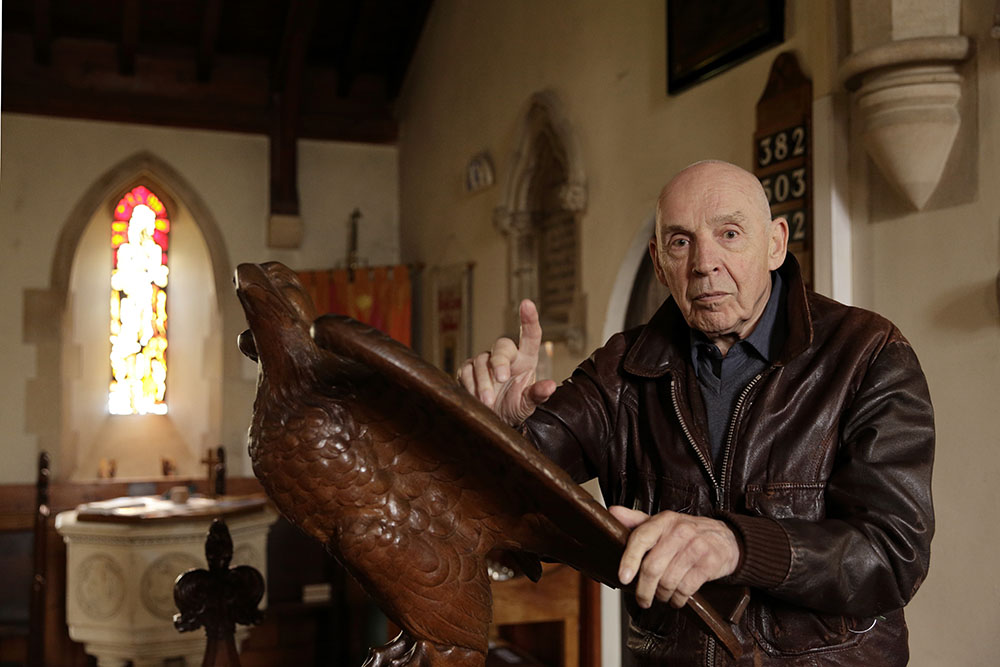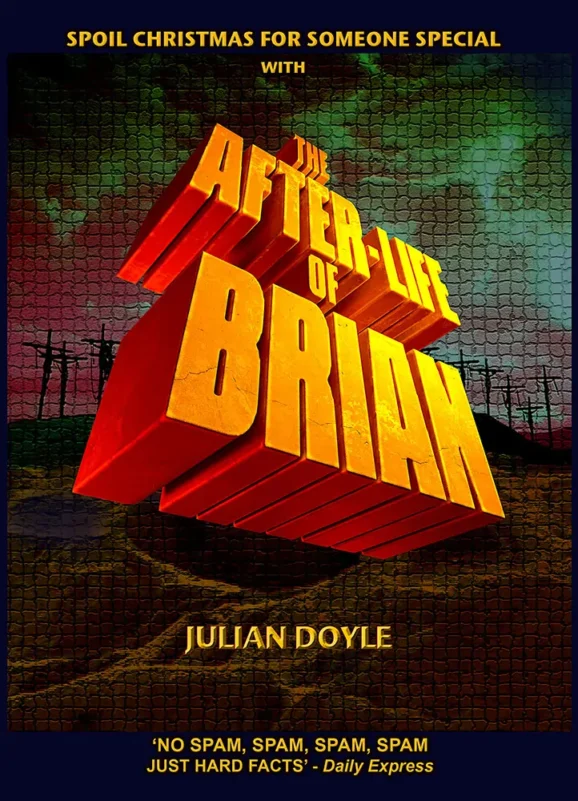Monty Python’s Life of Brian May Be More Accurate About The Historical Jesus Than The Bible

Julian Doyle
- Published
- Authors, Home, Opinion & Analysis

According to multi-award-winning film director, editor, scriptwriter, playwright, and author Julian Doyle — editor of classic comedy film Monty Python’s Life of Brian — the film may not only be hilarious but also offer a more accurate account of the life and times of Jesus than found in the Bible.
By Julian Doyle
It was sitting on the sand in Tunisia while watching the Monty Python team being crucified, during the filming of Life of Brian, when I realised something was seriously wrong with the process of crucifixion.
Over the next few days, as I edited the footage, I began to realise just what was wrong, but it took another 40 years of research to unravel the full extraordinary implications of what the Monty Python team had done.
They did not do it on purpose — their aim with Life of Brian had been simply to make another great comedy to match or even surpass Monty Python and The Holy Grail — but they are all well-educated chaps so they took things to their logical conclusions.
And those logical conclusions were devastating as far as the traditional biblical account of Jesus’ life were concerned.
Before I reveal their ‘heresy’ (not blasphemy, as they never set out to mock the Messiah but to satirise society’s tendency to sheepishly follow the religious dogma that tends to surround faith), let me just explain what was wrong with the crucifixion scene I had witnessed, the one where Brian (played by Graham Chapman) ends up being serenaded by Eric Idle’s Mr Cheeky singing Always Look on the Bright Side of Life.
Of course, we did not actually crucify the Pythons — we sat them on bicycle saddles for the long shots and for their close ups, they just stood on the ground and mimed to the playback of the song.
I was interested in history and had read ancient Jewish historian Josephus’ book on the Jewish war with the Romans, where he reports that in the siege of Jerusalem (70 CE), the Romans crucified 500 Jews. I had also read Plutarch’s account of the Spartacus revolt, where he reports 6,000 captured slaves were crucified on the Appian Way.
Not Seeing The Forest For The Trees
So the first question that struck me was very, very trivial, but it kept me awake: where did all those trees come from? Okay, three trees for Jesus and the criminals, but 500 during the siege of Jerusalem? Judea wasn’t, and isn’t, exactly a forest, so where did the trees come from, especially as it is reported that when the Crusaders’ laid siege to Jerusalem in 1099 CE, they dismantled their ships and carried the wood 35 miles to Jerusalem to make siege engines? Surely if there were plenty of trees they wouldn’t have bothered.
Indeed, ancient accounts attests that trees were a valuable commodity in the region, so why are the Romans using them to crucify a bunch of rebels in Galilee? I leave you to consider the implications while we begin to consider just one of the scenes that Monty Python filmed that unwittingly but expertly challenges the validity of the biblical account.

Filmmaker Julian Doyle says he first began to question the biblical account of Jesus’ life while filming Life of Brian in Tunisia.
A Quick Death
The normal method of capital punishment in Rome was beheading. Crucifixion is said to be reserved for slaves and rebels as it was meant to be more horrific.
But go watch Life of Brian. You’ll notice skeletons on the crosses. Do you get the implications? Neither did Terry Gilliam when I asked him why he did something so subversive. He just said it was probably his morbid sense of humour. But clearly it was also just so logical that he did it without thinking.
Why does the macabre image totally undermine the story in the Bible? Because, surely the purpose of crucifixion is to put the body on show as a deterrent, as long as possible, upright like a banner, struggling with pain, degraded and dehumanised, till the flesh rots.
Yet in the Bible it states that Jesus was on the cross for no more than six hours (John 19:14 and Matthew 27:45), so first one has to wonder why he died so quickly/ But then it is reported that after Jesus dies, Joseph of Arimathea goes to visit Pilate. Now just consider the conversation as reported in the Bible:
Joseph: “Can I have the body of Jesus?”
Pilate turns to a centurion: “Is he dead?”
Centurion: “Yes, sir, he is dead”
Pilate: “Okay, you can take him down now.”
What! Are they joking! They make a cross for a man, he carries it to Golgotha, they nail him up, and after a few hours he drops dead and Pilate says OK, you can take him down now! What an absurd amount of effort and time, not to mention a ridiculous use of a valuable tree, to kill a man. If you pop him up and then take him down after a couple of hours, why not just stab him and save all that time and money?
Some academics will retort that Jewish law says the body has to be removed by sunset. Do you really think Pilate would be moved by this to allow this body, or by implication, all Jewish victims to be taken down every Friday? Philo of Alexander describes Pilate as the most bloodthirsty of Governors in Israel: “A man of inflexible, stubborn and cruel disposition.”
Does this sound like a man who cares about Jewish Law? I think it is pretty clear that Pilate, or any Roman governor, would not care two hoots when staking a dangerous rebel. They would leave them up as long as possible to rot as a deterrent, exactly how Terry Gilliam had assumed when he put skeletons on the crosses.
So the important question are, if Pilate did want to kill Jesus, why didn’t he chop his head off? And why did Jesus die after only a few hours on the cross, and why was he then taken down and allowed a descent burial?

More than 40 years after the release of Monty Python’s Life of Brian, you might have thought the controversy would be over, but now everything is about to re-ignite with The After-Life Of Brian, which questions everything we thought we knew about the historical Jesus.
The After-Life of Brian
The answers are complex but are key to understanding the real story of the historical Jesus. And that has been my quest these past 45 years. In my new book, The After-Life of Brian, I finally bring together all this research together, underpinned by the key scenes from Life of Brian which are laugh-out loud funny but at the same time pose a big problem for the traditional biblical account.
In writing the book, my intention isn’t to offend. Everyone is entitled to their own belief and I have nothing but respect for it. But if you are open to the idea of examining the life of Jesus through the lens of logic and historical evidence rather than faith alone then it should provide some filling food for though.
The only warning I would give is lock your door before reading, just in case you receive an unexpected visit from the Spanish Inquisition.
The After-Life of Brian by Julian Doyle is out now on Amazon, priced £34.79 in hardcover and £5.79 as an eBook. For more information, visit www.juliandoyle.info
Sign up to The European Newsletter
RECENT ARTICLES
-
 Afore SURA awarded Pension Fund Management Company of the Year 2025
Afore SURA awarded Pension Fund Management Company of the Year 2025 -
 BOV Fund Services Limited wins in The European Banking & Finance Awards 2024
BOV Fund Services Limited wins in The European Banking & Finance Awards 2024 -
 Amberdata wins two titles in The European Banking & Finance Awards 2024
Amberdata wins two titles in The European Banking & Finance Awards 2024 -
 Ajman Bank wins in The European Banking & Finance Awards 2024
Ajman Bank wins in The European Banking & Finance Awards 2024 -
 Creditú wins three titles at The European Banking & Finance Awards 2024
Creditú wins three titles at The European Banking & Finance Awards 2024 -
 Krungthai Bank PCL wins five awards in The European Banking & Finance Awards 2024
Krungthai Bank PCL wins five awards in The European Banking & Finance Awards 2024 -
 Oakridge Property Group wins at The European Global Business Awards 2024
Oakridge Property Group wins at The European Global Business Awards 2024 -
 Old Mutual Investment Group wins two titles at The European Global Banking & Finance Awards 2024
Old Mutual Investment Group wins two titles at The European Global Banking & Finance Awards 2024 -
 AXA IM Select wins at The European Global Banking & Finance Awards 2024
AXA IM Select wins at The European Global Banking & Finance Awards 2024 -
 Zenith Bank Ghana wins five titles at The European Banking & Finance Awards 2024
Zenith Bank Ghana wins five titles at The European Banking & Finance Awards 2024 -
 SeABank awarded The Risk Management Bank of the Year - Vietnam 2024
SeABank awarded The Risk Management Bank of the Year - Vietnam 2024 -
 Vista Land & Lifescapes Inc. wins three titles at The European Global Business Awards 2024
Vista Land & Lifescapes Inc. wins three titles at The European Global Business Awards 2024 -
 Boursa Kuwait wins two titles at The European Global Sustainability & ESG Awards 2024
Boursa Kuwait wins two titles at The European Global Sustainability & ESG Awards 2024 -
 Gulf African Bank wins four titles at The European Banking & Finance Awards 2024
Gulf African Bank wins four titles at The European Banking & Finance Awards 2024 -
 Gulf Insurance Group awarded two Global Banking & Finance titles for 2024
Gulf Insurance Group awarded two Global Banking & Finance titles for 2024 -
 Eccelsa Aviation awarded three Global Business 2024 titles, including Best FBO Brand – Europe
Eccelsa Aviation awarded three Global Business 2024 titles, including Best FBO Brand – Europe -
 Afore Sura awarded Pension Fund Management Company of the Year 2024
Afore Sura awarded Pension Fund Management Company of the Year 2024 -
 Toledo Capital AG wins Best Boutique Wealth Management - Family Office 2024
Toledo Capital AG wins Best Boutique Wealth Management - Family Office 2024 -
 Banco de Chile awarded four Global Banking & Finance 2024 titles, including Bank of the Year - Chile
Banco de Chile awarded four Global Banking & Finance 2024 titles, including Bank of the Year - Chile -
 Kontora Family Office GmbH awarded Best Wealth Management Services - Germany 2024
Kontora Family Office GmbH awarded Best Wealth Management Services - Germany 2024 -
 Banque Misr awarded five Global Banking & Finance 2024 titles, including Best Banking Brand - MENA
Banque Misr awarded five Global Banking & Finance 2024 titles, including Best Banking Brand - MENA -
 Krungthai Bank PLC wins five awards in The European Banking & Finance Awards 2023
Krungthai Bank PLC wins five awards in The European Banking & Finance Awards 2023






















